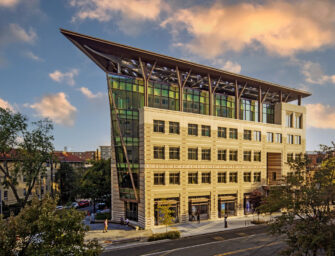Thoughts from the Geoscience Alliance on National Native American Heritage Month

Students in the Research Experience for Undergraduates on Sustainable Land and Water Resources visit a wild rice lake on the Fond du Lac reservation, with Natural Resources Manager Thomas Howes, who talks to the students about his job in promoting healthy rice lakes. Photo by Diana Dalbotten.
In November, the United States recognizes the significant contributions the first Americans have made to the establishment and growth of the U.S with National Native American Heritage Month. Writing this as members of the AGU and on behalf of the Geoscience Alliance, a national alliance to promote broadening participation of Native Americans in the geosciences, we wish to call attention of the scientific community to consider not only the past historical role Native Americans have played in sustainable management of the North American continent in the period before colonial settlement, but also the significant role Native Americans and their tribal governments play in the present day to protect and restore the environment. Tribal scientists are working to document, retrieve and preserve traditional ecological knowledge and apply this knowledge to modern day problems. Developing innovative techniques that combine culture, traditional knowledge and contemporary scientific practices, resource managers and tribal college students and faculty work to remediate environmental damage, extend protection to endangered species, sustainably management forests, protect clean water, and adapt to changing climate (Bueno Watts, et al., 2014). All this happens in the face of longstanding and ongoing challenges to tribal sovereignty established by treaties with the U.S. government (Norman, 2018).
This work can be seen across the country, but a few significant examples include:
* Salish Kootenai College, where multidisciplinary student research projects are strengthening scientific understandings of traditional foods used by the Salish, Kootenai, and Pend D’Orielle peoples in Montana. Projects focus on Blue Camas wetland restoration; traditional huckleberry phenological relationships with pollinators, predators, soil, and water; metal analyses of salmonids; and other related ecosystem service work such as climate-driven high mountain lake chemistry transitions that may impact future food availabilities.
* The Salish Sea Research Center at Northwest Indian College in the state of Washington, which encourages students to do hands-on research projects related to species protection and restoration along the northernmost coastline of Washington.
* In Minnesota, where research on wild rice involves collaboration between employees of the Fond du Lac Band of Lake Superior Chippewa, and faculty and staff from the University of Minnesota and has extended to include K-12 and undergraduate students, who have looked at the impacts of mining on this precious cultural resource.
* The Columbia River Inter-Tribal Fish Commission is a Yakama, Umatilla, Warm Springs and Nez Perce tribal coalition which works to “provide the tribes and the region with invaluable biological research, fisheries management, hydrology, and other science to support the protection and restoration of Columbia River Basin salmon, lamprey, and sturgeon…guided by holistic principles outlined in Wy-Kan-Ush-Mi Wa-Kish-Wit (Spirit of the Salmon), the tribal salmon plan.” Current projects are focused on climate change impacts on salmon, fish biology and genetics, and salmon restoration throughout the Columbia River Basin. (Information retrieved from: http://www.critfc.org/fish-and-watersheds/).
AGU members and the broader scientific community can take the following actions to support these and similar efforts:
* Become familiar with ethical considerations related to doing research on tribal lands
* Learn about current events impacting native lands and tribal sovereignty.
* Familiarize yourself with the concerns of tribes near you. Really listen to what kinds of expertise they might need, and decide what you may be able to assist with.
* Consider collaborating with tribal colleges on community-based participatory research projects.
* Learn about the barriers that keep the geosciences one of the least diverse fields in science, technology, engineering, and mathematics.
* Be engaged or actively participate in socio-political and economic concerns particularly where they potentially intersect tribal interests
* Broaden the perspectives of your respective communities through education, outreach, practice, and excellent communication to a range of audiences (e.g. scientific, business, political, tribal, citizen)
For more in-depth information, members of the Geoscience Alliance have recently released a new paper on partnerships between universities and tribal entities, “Gidakiimanaanawigamig’s Circle of Learning: A Model for Partnership between Tribal Community and Research University,” which discusses important considerations for these partnerships (Dalbotten et al., 2017).
References cited:
Bueno-Watts, N., Smythe, W., Geraghty-Ward, E., Dalbotten, D., Green, V., Tano, M., and Berthelote, A., “Geoscience Alliance: Building Capacity to Use Science for Sovereignty in Native Communities,” chapter in Dalbotten, D. M., Hamilton, P. and Roehrig, G. (eds), Future Earth, Advancing Civic Understanding of the Anthropocene, American Geophysical Union (AGU) Monograph, Hoboken: John Wiley and Sons, Inc., June 2014.
Dalbotten, D.M., Ito, M., Eriksson, S., Pellerin, H., Greensky, L., and Kowalczak, C., Gidakiimanaanawigamig’s Circle of Learning: A Model for Partnership between Tribal Community and Research University, International Journal of Partnership Studies, Vol. 4, No. 3, Fall 2017.
Norman, Emma, 2017. Standing Up for Inherent Rights: The Role of Indigenous-Led Activism in Protecting Sacred Waters and Ways of Life, Society and Natural Resources, Vol. 30, Issue 4.



This is so valuable & important to highlight this & every month. I hope that the AGU community continues to highlight the actions recommended here and to support Indigenous youth and scientists in research. It is good to be part of a time when exchanges of diverse ways of knowing and understanding science are finally taking place, even if they are close to 500 years overdo. Hahom (thank you) to the authors for sharing this!
[…] The full story can be found here. […]